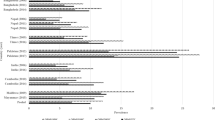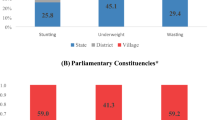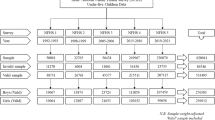Abstract
Objective:To devise a strategy for assessing the nutritional status of a household and specifying the major needs in combating childhood wasting, distinguishing between inadequate food availability, poor parental care and/or the need for improved public health measures.
Design: An evaluation of the relationship between children’s wasting, stunting, or underweight and mothers’ or adult women’s body mass indexes (BMIs) in the same household. A household was designated as ‘malnourished’ on the basis of a single child’s weight/height of <−2.0 s.d. or at risk of being malnourished if the Z-score was below−1.5. Adult women’s BMI was taken to signify adequate household food availability. Sibling concordance of anthropometric measures was investigated.
Results: A wide variety of prevalence of severe (BMI<16.0), moderate (BMI 16.0–16.9) and marginal (17.0–18.4) malnutrition existed in the various study areas. The worst condition was recorded in India, while 18% of the women in Zimbabwe were classified as obese. Similarly wide variation in the prevalence of child wasting and stunting was observed, with the Indian children again faring worst and those in Zimbabwe the best. The within-household analysis of concordance gave higher concordance for height than for weight between siblings. Mothers’ BMI was highly correlated with the BMI of all other adult women in the same household and the BMI of all the women was found to be as useful as that of the mother for relating to children’s anthropometry. Households with mothers of normal body weight but wasted children were designated as in need of public health measures and improved parental care rather than of enhanced food security. The distribution of households on this combined basis of maternal BMI and child nutritional status highlighted very diverse situations in the various study areas, with higher proportions of combined maternal and child malnutrition in India and in some areas of Ethiopia, while in Zimbabwe only 1–2% presented this condition. On this basis, the principal problem in India was food security; in Zimbabwe household security was rarely apparent, so public health measures and maternal care were designated as problems. In three Ethiopian communities there was a mixture of needs.
Conclusions: A relatively simple household-based approach is proposed to discriminate the most pressing needs in combating childhood malnutrition, and a policy-making tool is suggested for setting priorities in community action.
Sponsorship: Funds from ENI, IFPRI, DGXII of the European Community and the Italian government contributed to the surveys. The analysis was supported by the Scottish Office Agriculture, Engineering and Fisheries Department, by an FAO grant to WPTJ, and by STD2 Programme of the European Community–Contract No. TS2-M-0154-I provided to AFL.
This is a preview of subscription content, access via your institution
Access options
Subscribe to this journal
Receive 12 print issues and online access
$259.00 per year
only $21.58 per issue
Buy this article
- Purchase on Springer Link
- Instant access to full article PDF
Prices may be subject to local taxes which are calculated during checkout
Similar content being viewed by others
Author information
Authors and Affiliations
Rights and permissions
About this article
Cite this article
James, W., Ferro-Luzzi, A., Sette, S. et al. The potential use of maternal size in priority setting when combating childhood malnutrition. Eur J Clin Nutr 53, 112–119 (1999). https://doi.org/10.1038/sj.ejcn.1600686
Received:
Revised:
Accepted:
Published:
Issue Date:
DOI: https://doi.org/10.1038/sj.ejcn.1600686
Keywords
This article is cited by
-
Relationships between undernutrition prevalence among children and adult women at national and subnational level
European Journal of Clinical Nutrition (2005)



